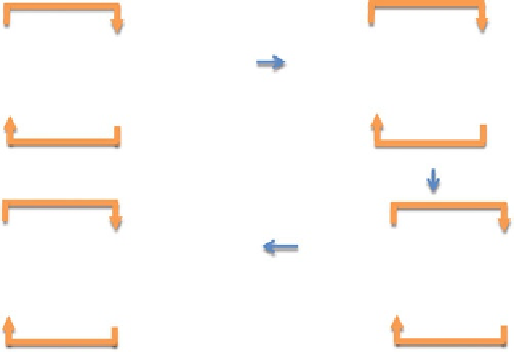Biology Reference
In-Depth Information
A
B
Experiment
(Mitochondrial
depolarization wave.
Dependence on ROS
scavenging)
Model
(Mitochondrial network modeling.
Depolarization wave. RiRR and
ROS scavenging modulation)
Model
(Inhibition or modulation of
oscillations in mitochondrial model.
Prediction
: GSH oscillations)
Experiment
(Mitochondrial
oscillations in cells)
Experiment
(Mitochondrial network
behavior - High
frequency domain.
Discovery
: Scale free
dynamics)
Model
(Mitochondrial ensemble dynamics.
Prediction
: High frequency
oscillations.
Simulation
: scale-free
dynamics & inverse power law)
Experiment
(Cellular level oscillations
in energetics &
electrophysiology)
Model
(Cellular model: triggering of
mitochondrial and action
potential oscillations)
D
C
Fig. 5.3 Overview of the experimental—computational synergy as applied to the elucidation of
the mechanisms involved in mitochondrial oscillations in the heart, and the discovery of scale-free
dynamics in the mitochondrial network
and the results of which then become a new functional/mechanistic insight into the
behavior of the experimental system. The loop can then reiterate from novel
behavior as experimentally verified, and this can subsequently be further
investigated in order to see if the model in its present form can account for the
new phenomena. If not, then the model is further refined and upgraded.
5.2 Oscillatory Phenomena in Cardiomyocytes: A Case
Study of Experimental-Modeling Synergy
In order to show how the experimental-computational synergy can be used to
address a specific biological problem, we analyze the experimental demonstration
of cell-wide mitochondrial oscillations in living cardiomyocytes (Figs.
5.3
and
5.4
).
To understand the mechanism underlying the oscillations, we developed a compu-
tational model of the mitochondrial oscillator (Cortassa et al.
2004
). One of the
aims of this modeling was to investigate the role of ROS in the mitochondrial
oscillations described in living cardiomyocytes subjected to oxidative stress
(Aon et al.
2003
).
In the heart, under normal physiological conditions, the availability of energy is
fine-tuned to match changes in energy demand. However, under stress this is not the
case. Metabolically stressful conditions such as substrate deprivation, or oxidative
stress,
represent a pathophysiological
situation under which mitochondrial

Search WWH ::

Custom Search